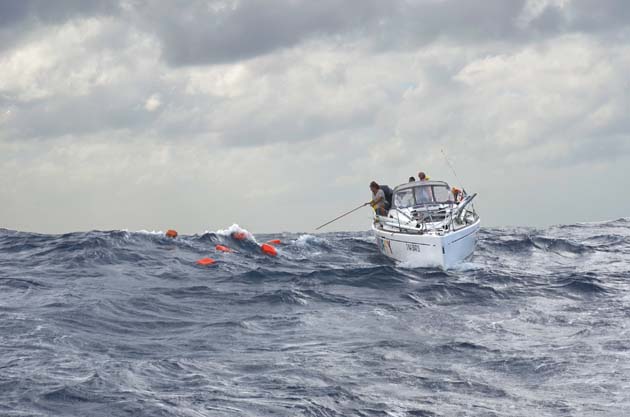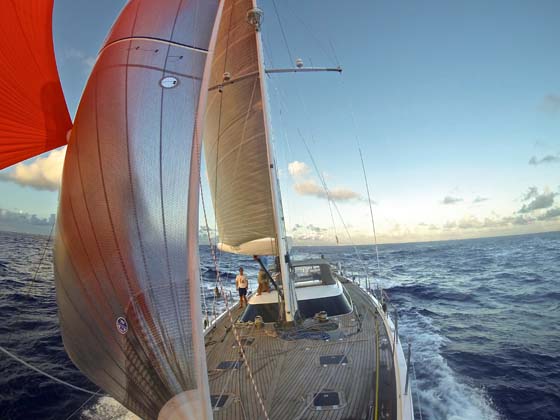Anyone who thinks crossing the Atlantic in the ARC is easy should think again. Elaine Bunting reports from the end of ARC 2015, where some boats got more than they had bargained for
The crew of Duffy, a Dufour 34, cut away the rigging and managed to recover a good portion of the spar on board. They were around 300 miles from the island of El Hierro, over 450 from Las Palmas, and so they turned back to motor to the Canary Islands. They contacted ARC control to say they were all OK and didn’t need assistance.
The Dufour 34 carries 264lt of fuel – more than sufficient for ISAF Category 1 regulations, which specify fuel for charging and a minimum of eight hours’ motoring – and quite likely more than enough to return to port if they made three to four knots against 25 knots of wind and the 8-9ft swell.

Jerrcans floated towards Duffy
But more diesel was not going to go amiss, so the following day they identified another ARC yacht, which happened to be an Oyster 66, Marlene F, and called them on the VHF to ask if they had any fuel they could spare.
On board Marlene F was professional skipper Wayne Gould. “When I plotted their position they were only five or ten minutes away,” he recalls. “We had six 30lt jerrycans of diesel that were three-quarters full, which is how I typically fill them because they’re easier to pour, and I knew they would float. So we strung them together, 3m apart, on a 15m line, so they would be easy to pick up with a boathook, and let that go [astern].”
Happy to help
With another 180lt of fuel on board as a safety net, Duffy motored back to Las Palmas. Later the skipper, Enrico Calvi, emailed Wayne Gould, thanked him and asked how to repay the yacht’s owner for the diesel and jerrycans.
 “There was a lot of joking about it when we suggested that he repay us in an equal quantity of good Italian red wine,” laughs Gould. “It was a small boat. I’ve been dismasted myself and I’ve done a fuel transfer at sea before too. We were happy to help.”
“There was a lot of joking about it when we suggested that he repay us in an equal quantity of good Italian red wine,” laughs Gould. “It was a small boat. I’ve been dismasted myself and I’ve done a fuel transfer at sea before too. We were happy to help.”
Good job all concerned. This was one incident of a few in what was otherwise a good ARC, and a fast one. But to my amazement, when I posted the photos (left) of the fuel transfer on Facebook, it attracted some disturbingly critical comments and a remark that problems on the ARC this year merited some serious investigations into participants’ preparations.
The internet has always attracted trolls and critics who like to suggest that they know better and would never themselves end up in a bad situation. But it also made me wonder if, over the years of covering the ARC, it has somehow been made to sound too easy, as if arriving in the Caribbean driven by wind and current is inevitable and only the most culpable fool could fail to make it.
Tough sailing
If that is the impression we have ever given about nearly 3,000 miles of sailing across the North Atlantic, then apologies for a misleading impression. Whether in the ARC or not, this can be tough sailing. It doesn’t matter that it’s downwind; it’s still hard on a yacht and it’s a demanding, stressful job for any skipper.
Preparing a yacht is burdensome. Chris Tibbs is a professional sailor, round the world race skipper, navigator and meteorologist who has made 25 Atlantic crossings, so he has the advantage of huge experience in choosing a yacht to sail with Helen, his wife, towards Australia.

Chris and Helen Tibbs and crew of Taisteali finish the ARC
Yet when I asked him before the start if he had enjoyed getting their Wauquiez 40S, Taistealai, ready he looked serious and said: “Fun sounds like the wrong word. It’s been hard work. Time is such a pressure. But it is very satisfying. This is the one that matters, because we’re doing it with friends and family.”
Chris wrote a feature on his preparations HERE. And his preparations paid off: the only breakage was the vang fitting, and the four crew, including Jeremy Wyatt of World Cruising, an experienced ocean sailor who was nevertheless doing his first ARC after 19 years of organising the event, hand steered all the way to finish in 16d 2h to take 5th place overall.
The crossing itself is often rough and bumpy, gear takes a battering it wouldn’t see in ten years of coastal cruising, crew get bruises in places you wouldn’t imagine, getting thrown around constantly in every activity from going to the loo to making a cup of coffee. It’s salty, the hatches might have to stay shut because of waves and spray, and you may not sleep it’s so hot and sweaty.

There are magical moments and spells of monotony. Some parts can be boring, or frustrating. Other crew may get on your nerves. Maybe you start off thinking you will be living the dream and find that a transatlantic crossing really is a challenge, like running a marathon. The London Marathon doesn’t get easier just because thousands of people have done it. Neither does the ARC. And it is never the same experience twice.
As dark fell on 3 December the skipper of Magritte, a Moody Grenadier 134 (a 43ft Giles design from the 1980s) contacted World Cruising to say they had a water ingress. They were 300 miles west of the Cape Verdes. The water level was rising and they were unable to find the source.
Mayday – going down
Dawn, and light on their troubles, was now ten hours away. MRCC Falmouth advised them to upgrade their situation to a Mayday. On receiving this, the nearest rescue centre at Cape Verde issued a request for a ship to divert to Magritte’s position to render them assistance.
The cargo ship SCL Basilea, en route from Brazil to Spain, arrived at 0500UTC, around nine hours after Magritte’s first contact with World Cruising. From on board the ship, Steve Arnold told us briefly in an Iridium email:
‘We made the liferaft ready, but didn’t deploy it as I felt it might get damaged or cut loose; the conditions were very bad. Long story, but we got a mooring line from SCL Basilea attached to our bow cleat and the crew pulled us alongside. We then attached a line to the stern. In 6m swells going from our boat to the vessel wasn’t easy, but with the crew’s help all went well.’

Magritte leaving Las Palmas
Around five hours later, the Yellowbrick tracker attached to Magritte sent its final position. The yacht is presumed to have sunk.
Arnold and his wife, Teresa, had left their jobs and were planning to sail round the world on the World ARC. They had prepared their boat alongside another couple on the ARC, Rick and Roz Smith, sailing their Oyster 56, Raya, who remark on the work carried out by the couple. Arnold had sailed on the Global Challenge ‘wrong way’ round the world race in 2004 and so had plenty of solid ocean experience.
Everything they planned is gone. It had made nearly every couple I spoke to at the finish in Saint Lucia reflect one more time on the seriousness of an ocean crossing.
Couples I meet who have taken up sailing relatively recently are often among those who have gone about the project with the most impressive focus, identifying the equipment and skills needed, and acquiring them methodically. They tackle it hand-in-hand, are usually unflinching about what they are getting into and thus are generally thoroughly prepared.




